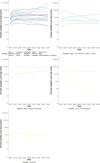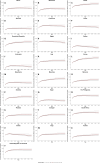Estimation and prediction on the economic burden of schistosomiasis in 25 endemic countries
- PMID: 40524274
- PMCID: PMC12168328
- DOI: 10.1186/s40249-025-01330-8
Estimation and prediction on the economic burden of schistosomiasis in 25 endemic countries
Abstract
Background: Schistosomiasis is a neglected tropical disease, primarily prevalent in tropical and subtropical regions. It imposes a significant health and economic burden in low- and middle-income countries, but a study of its comprehensive economic impact of the disease at the global level has not been carried out. As this is essential for evidence-based decision-making, this study aims to estimate the macroeconomic burden of schistosomiasis in 25 endemic countries.
Methods: We used a health-augmented macroeconomic (HAM) model, as well as observed data from 2010 to 2021 and projected data from 2022 to 2050, to model gross domestic product (GDP) under two scenarios: with and without schistosomiasis. The data were obtained from the Global Burden of Disease Study 2021 (GBD 2021), the World Bank database, the International Monetary Fund (IMF) database, the International Labour Organization (ILO) database, the United Nations Population Division's World Population Prospects 2022 database, the Barro-Lee Educational Attainment dataset, the Penn World Table (PWT) database, and relevant literature. The economic burden was quantified as the difference in GDP between these two scenarios. The HAM model considered: (i) the impact of schistosomiasis mortality and morbidity on labor supply; (ii) age and gender differences in education and work experience among schistosomiasis patients; and (iii) the impact of schistosomiasis treatment costs on physical capital accumulation. To be able to compare the purchasing power of different countries, we used international dollars (INT$), a hypothetical currency unit based on purchasing power parity.
Results: We estimated the macroeconomic burden of schistosomiasis in 25 schistosomiasis endemic countries was INT$ 49,504 million [uncertainty interval (UI): 48,668-50,339] for the study period, using a 3% discount rate in the main analysis. The result implies that the economic burden of schistosomiasis across these 25 countries during study period is equivalent to 0.0174% (UI: 0.0171-0.0177) of total GDP. Among all schistosomiasis-endemic countries included, Egypt had the largest absolute economic burden (INT$ 11,400 million, UI: 11,221-11,578), followed by Brazil (INT$ 9779 million, UI: 9717-9841) and South Africa (INT$ 6744 million, UI: 6676-6811).
Conclusions: The global economic burden of schistosomiasis remains substantial and is inequitably distributed among countries and regions. Our study highlights the need for increased investment and global collaborative efforts to control schistosomiasis and its associated health and economic burdens. By advancing the elimination of schistosomiasis, substantial economic returns can be achieved.
Keywords: Economic burden; Elimination; Endemic country; Global burden; Macroeconomic model; Schistosomiasis.
© 2025. The Author(s).
Conflict of interest statement
Declarations. Ethical approval and consent to participate: Not applicable. Consent for publication: Not applicable. Competing interests: Xiao-Nong Zhou is the Editor-in-Chief of the journal Infectious Diseases of Poverty. He was not involved in the peer-review or handling of the manuscript. The authors have no other competing interests to disclose.
Figures



Similar articles
-
The global economic burden of chronic obstructive pulmonary disease for 204 countries and territories in 2020-50: a health-augmented macroeconomic modelling study.Lancet Glob Health. 2023 Aug;11(8):e1183-e1193. doi: 10.1016/S2214-109X(23)00217-6. Lancet Glob Health. 2023. PMID: 37474226 Free PMC article.
-
Estimates and projections in the economic impacts of fifteen dietary risk factors for two hundred four countries and territories from 2020 to 2050: A health-augmented macroeconomic modeling study.Am J Clin Nutr. 2025 May;121(5):1099-1108. doi: 10.1016/j.ajcnut.2025.03.002. Epub 2025 Mar 5. Am J Clin Nutr. 2025. PMID: 40054623
-
The global macroeconomic burden of Alzheimer's disease and other dementias: estimates and projections for 152 countries or territories.Lancet Glob Health. 2024 Sep;12(9):e1534-e1543. doi: 10.1016/S2214-109X(24)00264-X. Lancet Glob Health. 2024. PMID: 39151988
-
Global economic consequences of selected surgical diseases: a modelling study.Lancet Glob Health. 2015 Apr 27;3 Suppl 2(Suppl 2):S21-7. doi: 10.1016/S2214-109X(15)70088-4. Lancet Glob Health. 2015. PMID: 25926317 Free PMC article. Review.
-
Folic acid supplementation and malaria susceptibility and severity among people taking antifolate antimalarial drugs in endemic areas.Cochrane Database Syst Rev. 2022 Feb 1;2(2022):CD014217. doi: 10.1002/14651858.CD014217. Cochrane Database Syst Rev. 2022. PMID: 36321557 Free PMC article.
References
-
- GBD 2021 Diseases and Injuries Collaborators. Global incidence, prevalence, years lived with disability (YLDs), disability-adjusted life-years (DALYs), and healthy life expectancy (HALE) for 371 diseases and injuries in 204 countries and territories and 811 subnational locations, 1990-2021: a systematic analysis for the Global Burden of Disease Study 2021. Lancet. 2024;403(10440):2133–61. - PMC - PubMed
-
- King CH, Galvani AP. Underestimation of the global burden of schistosomiasis. Lancet. 2018;391(10118):307–8. - PubMed
-
- Lo NC, Bezerra FSM, Colley DG, Fleming FM, Homeida M, Kabatereine N, et al. Review of 2022 WHO guidelines on the control and elimination of schistosomiasis. Lancet Infect Dis. 2022;22(11):e327–35. - PubMed
MeSH terms
Grants and funding
LinkOut - more resources
Full Text Sources
Research Materials

